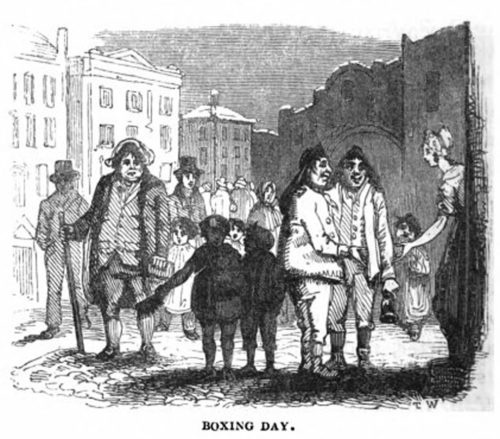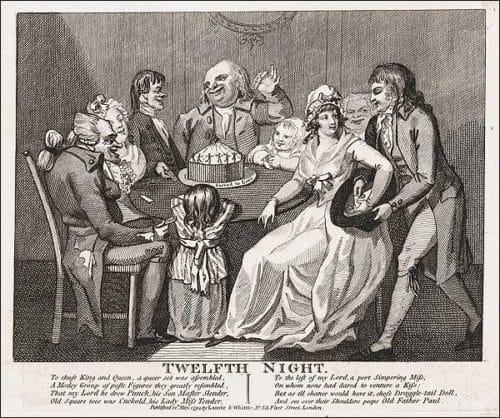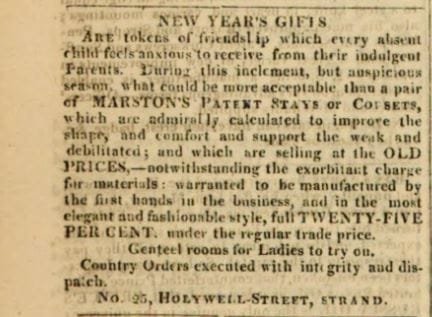Regency era Holiday Gift Giving

Gift giving in Jane Austen’s Day. What might she have given or received for Christmas?
Though gift giving was not the primary focus of the Christmastide season, gifts were commonly exchanged. St. Nicholas Day, Christmas Day, Boxing Day and Twelfth Night were the most likely days for gift exchange. Old traditions called for gifts to be exchanged on New Year’s Day.
Many gifts exchanged were gifts of obligation between unequal parties. Landowners and the well-off presented charitable gifts to beggars and the poor of the community. They also provided favors to their tenants, servants and tradesmen they patronized. These tokens might be coins, food, particularly expensive foodstuffs, or castoff clothes and goods.
Gifts might also be presented from those lower in status to those above them. Beggars offered songs, holly springs or simple handicrafts to their benefactors. Tradesmen might send special goods like Yule Candles to their best patrons. Tenants might bestow gifts of their harvest to the landowner in recognition of generosity and possibly to encourage him not to raise their rents.
Social equals like friends and family also might indulge in gift giving, though men and women did not exchange gifts unless they were married, engaged or related by blood. These gifts were generally more personal in nature than obligatory gifts.

Ladies might showcase their accomplishments in their gifts. Skilled hands prepared embroidered handkerchiefs and slippers for loved ones. Clever needles could create scarves, shawls, laces, trims and similar items. Paintings, drawings and other decorative arts graced a variety of gift items.
Gifts could be and often were purchased, with clothing and jewelry (especially that made with locks of hair) being among the most common items for both sexes. Books, sheet music, fancy boxes and supplies for activities like writing or handicrafts were also popular.
Emma Smith, who eventually married the Rev. James Edward Austen Leigh, Jane Austen’s nephew and publisher of A Memoir of Jane Austen made records of the Christmas gifts she received. A peek at her lists gives us a look at what kids of gifts were commonly exchanged.
At age twelve, in 1813, she notes that her father gave her a tambourine and her mother a compass case. Her governess gave her a straw box and her aunt, a parallel ruler. Through the years, she received among her gifts: a silver vinagrette (for smelling salts), a knitting box embellished with a drawing by the giver, a box for embroidery silks, handmade purses, a locket with the giver’s hair, a peacock feather screen made by the giver, ruffles, also made by the giver and various pieces of jewelry, pendants, brooches and rings, music and an inkstand.

Gift giving became more prevalent toward the end of the Regency period and into the Victorian. Advertisers began to run ads in periodicals suggesting novel ideas for gifts. One 1814 advertisement in Ackermann’s Repository suggested Marston’s patent stays and corsets, designed to comfortably support the weak and debilitated were a most acceptable gift for one’s parents. I might just pass on that advice.

What fun. I can’t tell… but is that guy in the picture discretely [hidden by his hat] slipping something to the young lady? Or perhaps… she to him? You can’t be sure. Thanks for sharing.
Thanks JW!
I used to use my accomplishment of knitting & crochet to make presents when my children were small. I made hat and scarf sets to order as well as dolls clothes and baby blankets and clothes. I also used to crochet table mats and bookmarks.
When I was at junior school I embroidered handkerchiefs and made spill holders. I think the only slippers I made were for my children as babies for the winter. I also crocheted baskets for them filled with chocolate eggs and a small toy for Easter.
Nowadays I struggle to put my book or kindle down to create anything 🙂
I love handmade gifts, they are truly so special. Wish I had more opportunity to do them.
Very enjoyable and you’ve put a lot into this post.
Thanks Teresa!